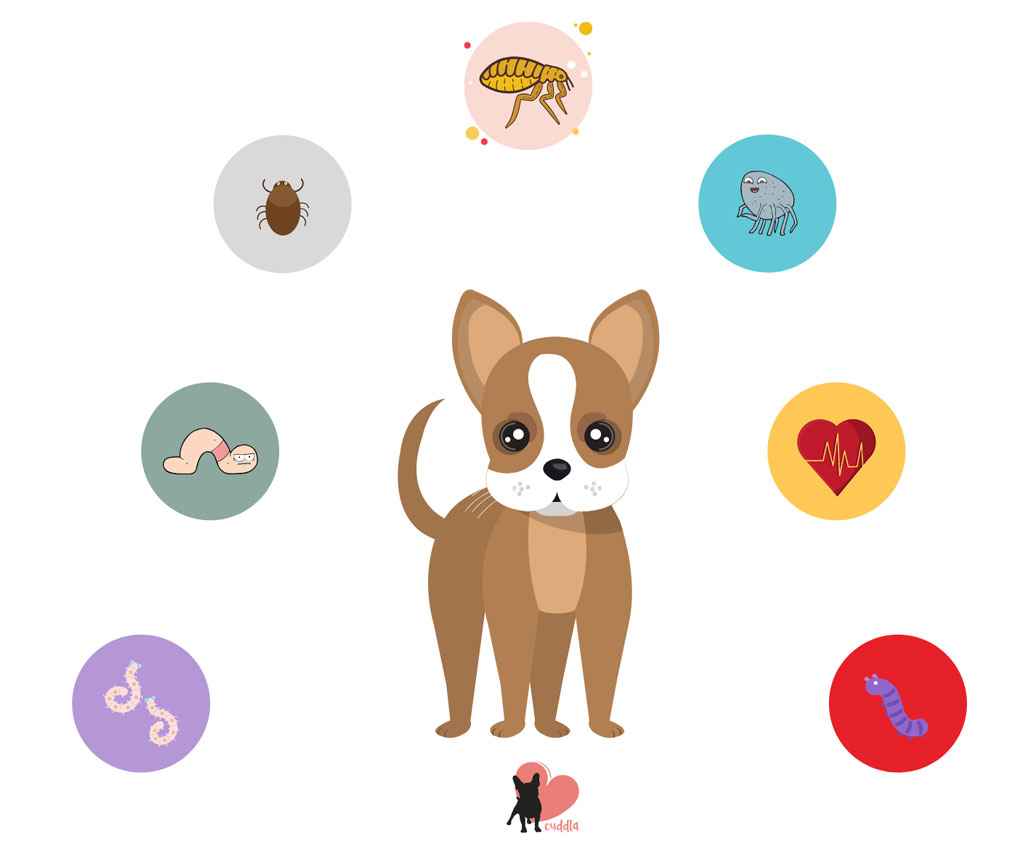
Dogs can suffer from different types of parasite that, if left unattended, can cause serious health problems for your dog.
So how can you prevent and treat dog parasites? The best way to help and prevent your furry friend from these parasites is to visit the vet. There your dog will go for faecal, haematological examination, and blood smear examinations.
For dog parasite treatments, immediate action is necessary. There are many commercial products for different parasite treatments. However, natural remedies are also a healthy alternative.
Here are things to know about dog parasites, in order to spot the signs, know the causes, prevention tips and treatment options.
Types of Dog Parasites
Internal:
- Heartworms.
Intestinal:
- Hookworms.
- Ringworms.
- Roundworms.
- Tapeworms.
- Whipworms.
- Coccidia, Giardia, and Spirochetes (non-worm parasites).
External:
- Fleas.
- Ticks.
- Lice.
- Mites.
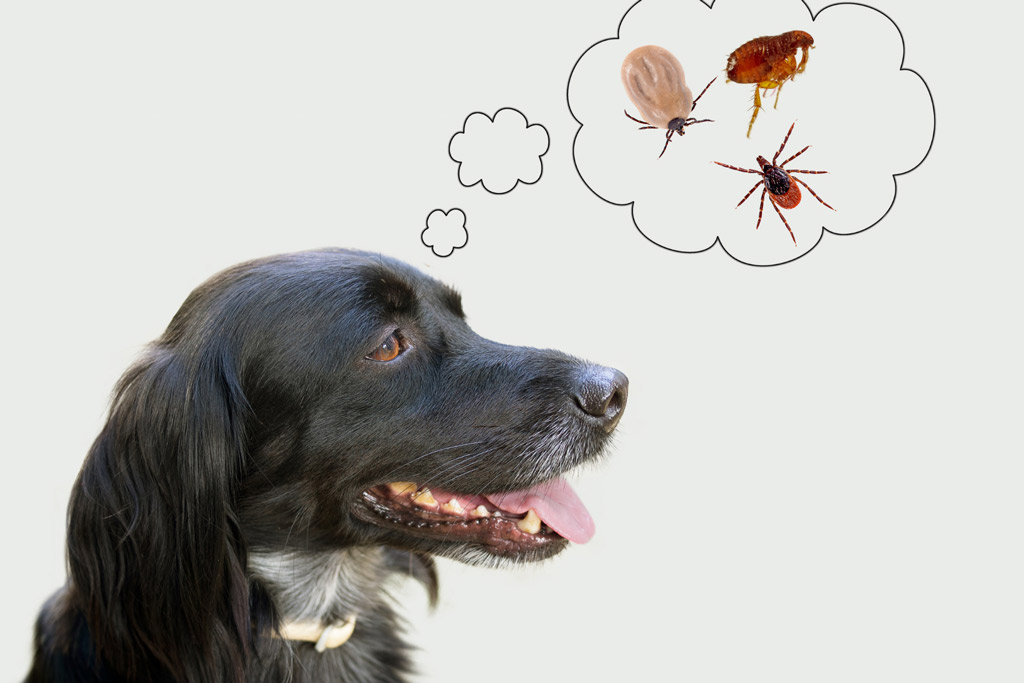
Worms
Although it’s true that areas with a large mosquito population have higher incidences of heartworm disease, this condition has been diagnosed in all 50 states in the U.S.
According to the 2016 heartworm prevalence map published by the Companion Animal Parasite Council (CAPC), 1 out of every 76 dogs in the U.S. — less than 1.5% — tests positive for heartworm.
Dogs are considered to have higher risks of heartworm infection in 13 states, primarily in the southeast, where soaring temperatures and high humidity during the warmer months of the year provide an ideal environment for mosquitoes to thrive.
For example, if you live on the Gulf Coast in either Texas or Florida where mosquitoes are a problem, the map suggests you begin giving a preventive on day one of month 1 (January 1st) and give it year-round.
However, if you live in western Oregon or Washington, the map suggests you start dosing on August 1 and stop on October 1.
Heartworm is not a major concern in the UK, as there are far fewer mosquitos than in countries such as the USA and Spain, where heartworm is more widely prevalent.
Although many imported dogs in the UK can develop signs of heartworm, once treated, reinfection in the United Kingdom is unlikely. But if the dog is re-exported, continuous treatment to prevent recurrence will be necessary.
Even though the Pet Travel Scheme (PETS) has made it far easier to take our dogs with us abroad, it’s still a concern to bear in mind when you are planning to take your dog with you on holiday.
Veterinarians do not habitually prescribe preventative medication for heartworm in the UK, so it is vital you consider preventative medicine before you travel.
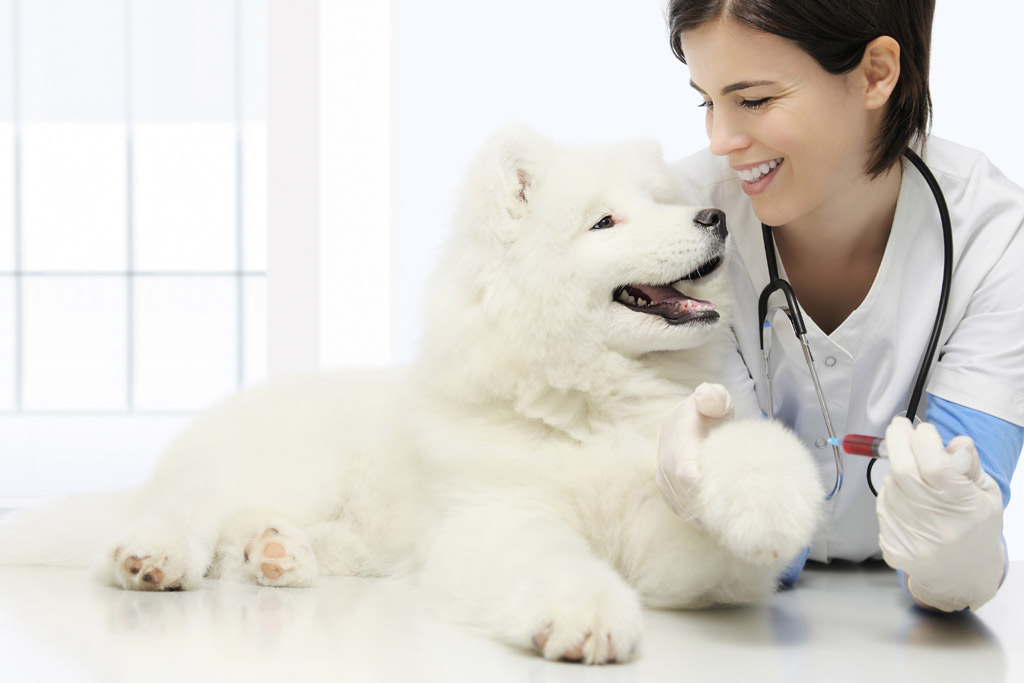
Insider Tip: You should visit your vet a month before your trip to discuss and determine whether heartworm is an issue in the country that you are planning to visit.
Heartworm is very easy to prevent with the correct medication and treatment should be administered for at least three weeks before you travel; continue the treatment while you are abroad, and continue to treat for at least a month upon returning.
If you have recently travelled with your dog to an area where heartworm is known to occur and you have not taken preventative measures, ask your vet to analyse a sample of your dog’s blood for heartworm. Heartworm is much easier to treat in the early stages before major symptoms occur.
Should your dog become ill with the symptoms of heartworm after travelling abroad, ensure you tell your vet details of the journey, even if the trip occurred a while ago.
Types of Worms
There are four types of intestinal worms that pose the majority of risk to dogs. The most serious is roundworm but hookworms, whipworm and tapeworms are also found.
Here are the various types of worms that can affect your dog:
Heartworms
Heartworms in dogs live in the heart and pulmonary arteries. They are transmitted only from an infected mosquito’s bite, and they migrate throughout the body over about 6 months before finally coming to rest in the circulatory system.
They are preventable and treatable but can be fatal if not diagnosed and arrested before the advanced stages of infestation.
Roundworms
The most common dog worms of all types. They live in the small intestine. Roundworms in dogs grow reach 3-5” long in adulthood, and they resemble a piece of wet spaghetti.
The roundworm larvae start by infecting a dog’s intestinal tract, but they can burrow their way into other tissues and organs.
Roundworms in dogs can be transmitted via the nursing process or by contact with the infected faeces of another animal.
Tapeworms
Adult tapeworms also live in the small intestine. They shed segments which are passed in poop. These look a bit like grains of rice and can sometimes be seen around the tail and the area around your dog’s bottom.
Tapeworms in dogs have long and flat ⅛” segmented bodies that can grow to 8 inches in length.
Tapeworms in dogs happen when a dog encounters or ingests a host that is carrying tapeworm eggs, like a bird or a flea.
Hookworms
Hookworms in dogs are the smallest of all common dog worms varieties. They reside primarily in the small intestine. They grow to approximately one inch in length and feed on the blood.
They can cause life-threatening anaemia in dogs of all ages, but especially puppies. Hookworms are passed in the dog’s poop.
Whipworms
Whipworms in dogs are about ¼” long and live in the dog’s large intestine (the cecum and colon). They resemble a very small piece of thread.
Unlike other parasitic worms, they are very difficult to spot in a stool sample. Weight loss is the chief symptom of a whipworm infestation.
Whipworms can cause severe damage to your dog’s organs and are considered one of the most harmful dog worms in existence, but are also more geographically distinct than other dog worms.
Ringworm
Ringworm, or dermatophytosis, is a skin disease caused by a fungus that results in lesions and sores on the epidermal (or outer skin) layer. The lesions cause circular bald spots which sometimes look red in the centre.
However, ringworm is not caused by a worm at all, but rather by an infection of dead layers of skin, hair and nails. It’s actually a fungus.
Ringworm is curable, but treatment can take time and the condition can be very painful for your dog.
Coccidia, Giardia, and Spirochetes
They are invasive, non-worm parasites that live in a dog’s intestinal tract. What makes them particularly dangerous is that they can infect a dog before he actually appears sick.
Coccidia is single-celled and found more frequently in puppies, where they may acquire it through their littermates or mother.
Spirochetes can live in the bloodstream, as well as in the intestine, and can cause Lyme disease, syphilis, and other serious diseases.
Giardia is found throughout the U.S. and is, unfortunately, a pervasive protozoan (parasite).
Transmission of these parasites can come from infected soil, water, faeces, food, other animals, and more.
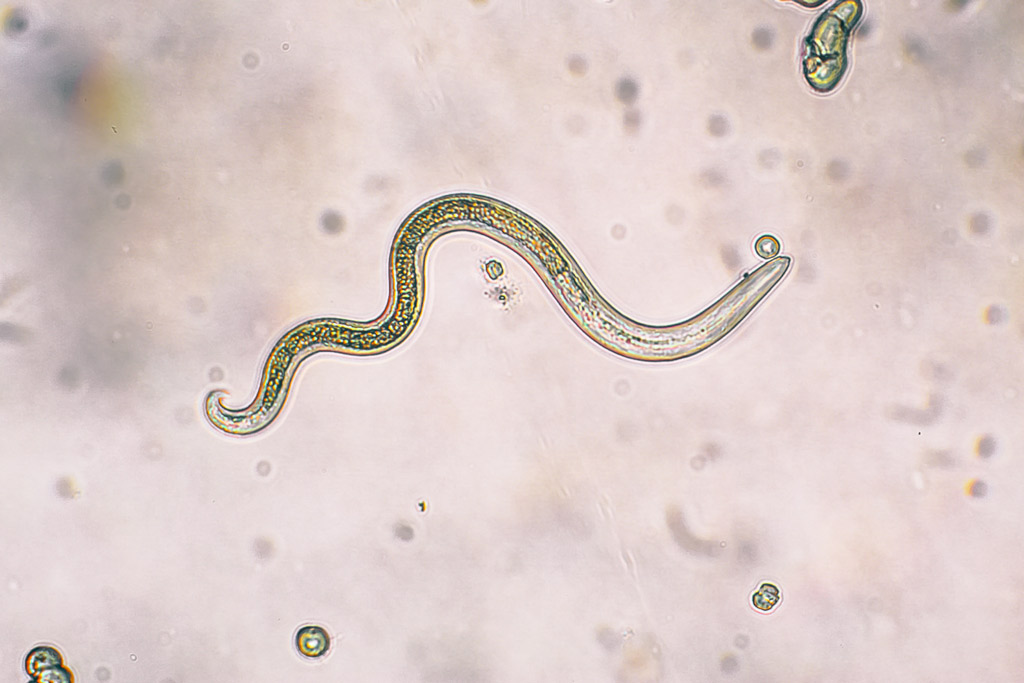
Signs Your Dog Has Worms
The signs that your dog has tapeworms or roundworm include:
- Diarrhoea.
- Passing worm segments in poop.
- Pot-bellied appearance.
Signs of lungworm include:
- Changes in behaviour such as low energy (lethargy).
- Breathing problems, coughing, tiring easily or fainting.
- General sickness including weight loss, diarrhoea, vomiting and not wanting to eat.
- Bleeding problems such as bruising easily, blood blisters on the gums, pale gums or nose bleeds.
Causes of Worms
The most common causes are:
- Swallowing larvae from mother’s milk.
- Inheriting the infection from their mother.
- Eating dead animals or killing animals outside and eating them.
- Having fleas and swallowing them whilst grooming.
- Picking up worms or larvae from poop whilst outside.
- Contact with or swallowing slugs or snails (lungworm).
- Ingesting contaminated soil by grooming themselves and consuming contaminated dirt in their fur.
- Walking on contaminated soil, parasites can penetrate any part of the dog’s skin that touches infected soil, such as the paws or belly.
Worm Prevention
If you live in a heartworm endemic area of the country, work with your holistic or integrative veterinarian to develop a sensible preventive protocol to keep your pooch safe and healthy.
You can plan whether there is any need to go for heartworm prevention throughout the year or only in some months of the year. For example, in the case of some countries, the mosquitoes may be dormant in most of the colder months.
Always insist on a heartworm test before beginning any preventive treatment. Puppies need to be tested for the evidence of these worms when they are 6 months old.
If your dog has spent a lot of time outdoors during warmer weather, we recommend running a blood test every six months. The reason to test every six months is that parasites are becoming resistant to heartworm, flea and tick chemicals. The sooner you identify an infection in your dog, the sooner a protocol can be instituted to safely treat it with fewer long-term side effects.
As a home preventive measure, avoid water stagnation around your dog’s outdoor shelter and bushes around the area that facilitates mosquito breeding.
Insider Tip: Let garden spiders grow, since they kill insects like mosquitos and flies.
Worms Treatment
The most common treatments for worms are:
- Tablets.
- Powders.
- Chews.
- Pastes.
- Spot-on treatments.
Always insist on a heartworm test before beginning any preventive treatment.
It’s also worth noting that heartworm preventive drugs are not harmless. They are chemical pesticides with the potential for toxicity. In addition, there is a growing problem of heartworm resistance to preventives.
With guidance from your veterinarian, try using natural preventives like heartworm nosodes rather than chemicals. Make sure to do heartworm testing every three to four months (not annually), as natural heartworm preventives can’t guarantee your dog will never acquire the disease.
Remember, heartworms live in your dog’s bloodstream, so natural GI (gastrointestinal) dewormers, such as diatomaceous earth, and anti-parasitic herbs (such as wormwood, pumpkin seed and black walnut tinctures) are not effective at killing larvae in the bloodstream.
Avoid all-in-one chemical products claiming to get rid of every possible GI worm and external parasites as well. The goal is to use the least amount of chemical necessary that successfully treats heartworm. Adding other chemicals to the mix adds to the toxic load your dog’s body must contend with. Also, avoid giving your dog a chemical flea/ tick preventive during the same week.
Follow up all heartworm medications given with natural liver detox agents like milk thistle and SAMe, in consultation with your veterinarian.

Fleas
Fleas are tiny wingless six-legged insects that feed on mammals, including dogs. They go through four life cycle stages:
- Egg.
- Larva.
- Pupa.
- Adult.
The adults live on animals like dogs, where they lay their eggs. These eggs spread throughout your home and yard every time your dog scratches, shakes or lies down.
Then they hatch into larvae in your dog, but also carpet, sofa, or bed. The larvae form cocoons during the pupa stage, where they hatch and become adults that infest their animal hosts.
Knowing the different stages helps you know how to treat fleas and what products to go for.
Causes of Fleas
The truth is that healthy, well-nourished, unstressed animals are unlikely to attract fleas. Fleas, ticks, and other parasites attach themselves to unhealthy animals.
If your dog has developed fleas, most likely it has to do with the two causes of all disease: nutritional deficiency and toxins.
However, your dog can pick up these parasites when:
- Walking or playing in locations that may be flea-infested, whether you know it or not.
- Going to warm, dark and moist places or walk on woodpiles, leaves, and grass clippings that are also prone to acquiring fleas.
- Exploring other places such as animal dens, which are known as hiding places for fleas.
- Interacting with other dogs in a park or a kennel.
- Coming in contact with wild animals like rabbits, squirrels, and foxes that could also be carriers of fleas.
Fleas produce skin reactions like allergies and your dog will start severely scratching his body. Quite often, fleas can cause severe dermatitis in dogs.
As a result, your dog won’t be able to rest properly and can result in bacterial invasions if not treated. Apart from affecting your dog, it can also affect other members of your household, especially children, who play with them.
That’s why a regular close observation of your dog’s skin is highly recommended to keep an eye on fleas, ticks, lice, etc.
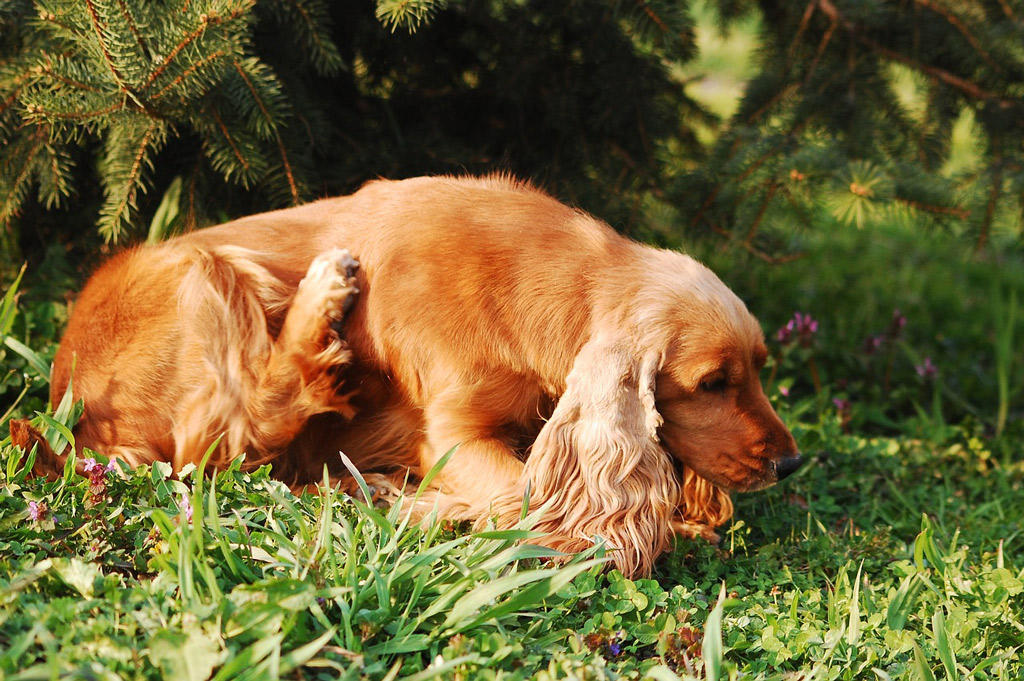
Flea Prevention
There are a few things you can do to prevent fleas:
- Treat all the dogs regularly (once a month).
- Regularly wash all your dog’s beds on a hot wash (60 degrees Celsius) to get rid of any flea eggs.
- Use a long-acting household spray regularly (both indoors and outdoors).
- Clean and vacuum your whole house, especially in the hot, humid places where fleas like to hang out. It’s best to do it at the same time you treat your dogs. Get rid of the vacuum bag or empty the canister when you’re done; preferably do it outside your house.
Before Treating Fleas
Before you pursue any treatment you should clean everything. This means from your bedding to your towels to anything your dog lies on. Make sure you wash it all, and in hot water if possible.
Vacuum every floor and couch and be sure to empty the vacuum bag. Then fasten that bag securely. Place it outside so that none of those unwanted pests make their way back into your home!
Clean your hard surfaces and after washing everything – including your dog – you’re ready to start your flea treatment.
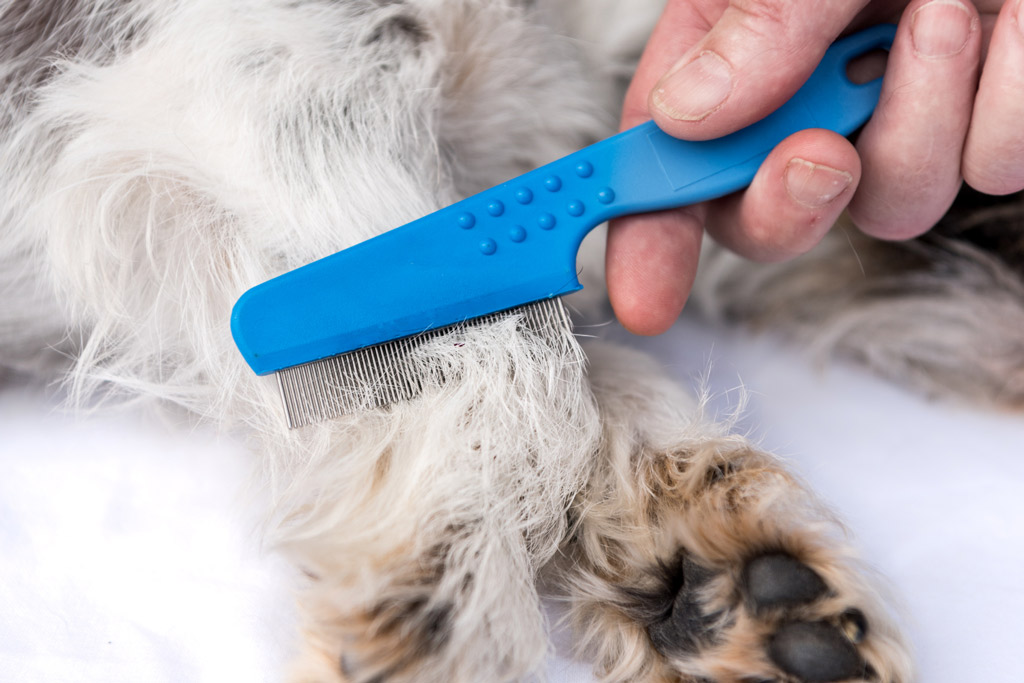
Flea Treatments
After cleaning everything, you can implement a natural remedy to get rid of fleas.
First, try combing your pooch using a fine-toothed, metal flea comb. Use it while they are lying down on a white piece of paper or while they are sitting down. If you notice black spots that look like dirt and turn red when placed on a damp piece of paper, then they are fleas.
To treat fleas in dogs, you can try using specially formulated natural and organic shampoos. Just make sure to use cold water when rinsing the shampoo. Warm or hot water can exacerbate itching, while cold water can help in alleviating inflammation.
You probably want to avoid toxic treatments like anti-parasite collars, sprays, powders, shampoos, etc. The ingredients in these products are related to:
- Neurological and respiratory problems.
- Skin and gastrointestinal irritations.
- Cancer.
- Organ failure and death.

Natural Flea Treatments
Here are some natural treatment methods that also can work for your doggy:
Lavender Essential Oil:
- Place a few drops of Lavender Essential Oil at the back of your dog’s neck and at the base of the tail to control a flea infestation.
- You can always dilute the essential oil in water if necessary. Remember that essential oils are highly concentrated, so you don’t need more than a few drops.
Rosemary Flea Dip:
- Take 2 cups of fresh rosemary sprigs, boil them in water for half an hour and strain the liquid.
- Add the resulting mixture to 4.5L of water.
- Once the solution is warm, pour the water on an infested dog and let it air dry.
If your dog does not respond well to any of these natural treatment methods or if he already has a drastic flea infestation, consult your veterinarian immediately to help you come up with an effective solution.
What About Your Household?
Finally, don’t forget about addressing your home if you are facing a flea problem. Washing everything, as mentioned before, is not enough. To treat your household, prepare a herbal flea spray that consists of:
- 4.5L of vinegar.
- 2.2L of water.
- 0.5L of lemon juice.
- 0.25L of witch hazel.
Put this mixture into a garden sprayer and spray this mixture after you have vacuumed your house. Do it especially on carpets, furniture, dog bedding, windowsills and floors to get rid of fleas.
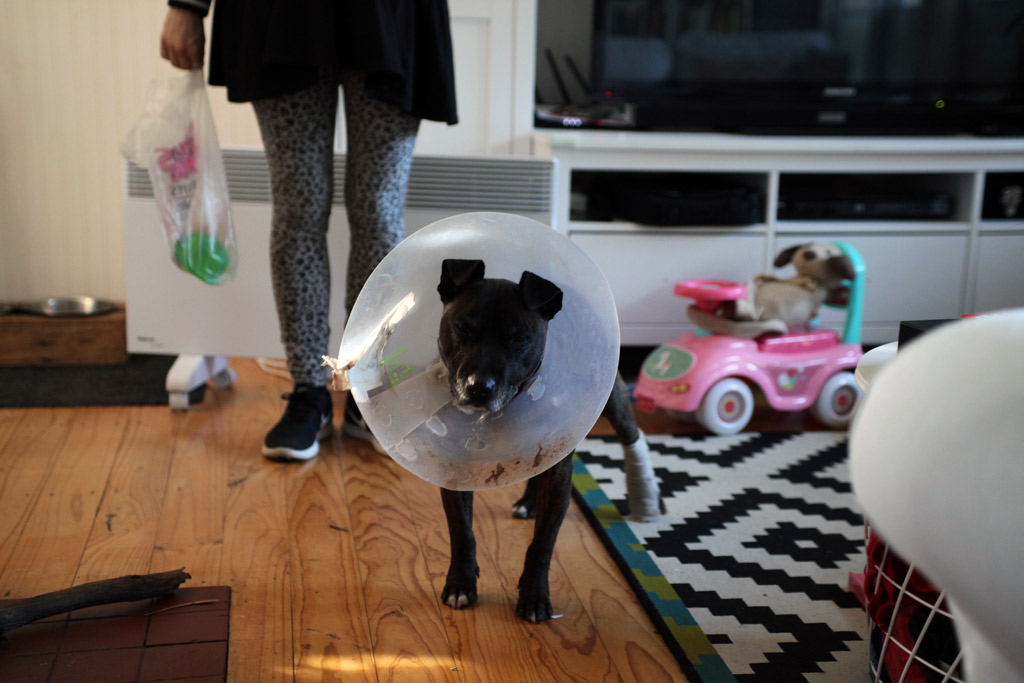
Ticks
Ticks are of the arachnid family, can survive at near-freezing temperatures and can cause a number of serious illnesses, including canine tick-borne diseases such as:
- Lyme disease.
- Ehrlichiosis.
- Rocky Mountain Spotted Fever.
They feed on the blood of mammals, birds, and reptiles. Multiple ticks may deprive your dog of enough blood to cause the deficiency called anaemia, and certain female ticks produce a toxin which can even cause a rare paralysis in your dog.
Signs Your Dog Has Ticks
Here are some of the clearest signs that your dog may be carrying this parasite:
- Skin irritation and itching.
- Inflammation and redness around the bitten area.
- Mild to high fever.
- Loss of appetite.
- Lethargy and fatigue.
- Depression and reduced personality.
Any of these symptoms may occur for only a few hours, or continue for days or weeks. If your dog is showing these signs, it’s worth checking for ticks.

Tick Prevention
The best way to tackle ticks is to act before they find their way onto your dog. You can start by:
- Checking for ticks daily.
- Avoiding tick-infested areas.
- Keep your garden clean of weeds, mowing the lawn frequently and keep other animals at bay.
- Use natural repellants.
How to Remove Ticks
Whenever you see a tick, take it off immediately. This will prevent further complications. Removing ticks is straightforward and painless for both dog and owner if you know what you’re doing.
You will need:
- Tweezer: You can sterilize them by submerging the tweezers in boiling water for a few minutes and allowing to cool before use.
- Tick removal hook: Alternatively, instead of tweezers, you can use a tick removal hook like the Tick Twister. You simply put the prongs on either side of the tick and twist upward.
- Non-isopropyl alcohol: To clean the bite.
- Disinfectant: To clean the tweezers.
The best way to remove a tick is by using a pair of tweezers. You should use fine-point tweezers to avoid tearing the tick and spreading possible infections into the bite area.
- Spread your dog’s fur.
- Grasp the tick as close to the skin as possible with the tweezers.
- Very gently, pull straight upward, in a slow, steady motion. This will prevent the tick’s mouth from breaking off and remaining embedded in the skin.
- Clean the bite site with the alcohol.
- Dispose of the tick in the bin once it’s dead (you can place it in alcohol to kill it).
- Rinse the tweezers with disinfectant.
- Wash your hands. You can also use gloves if you prefer.
Insider Tip: Never remove a tick with your fingers. Apart from being ineffective, the squeezing may also further inject infectious material.
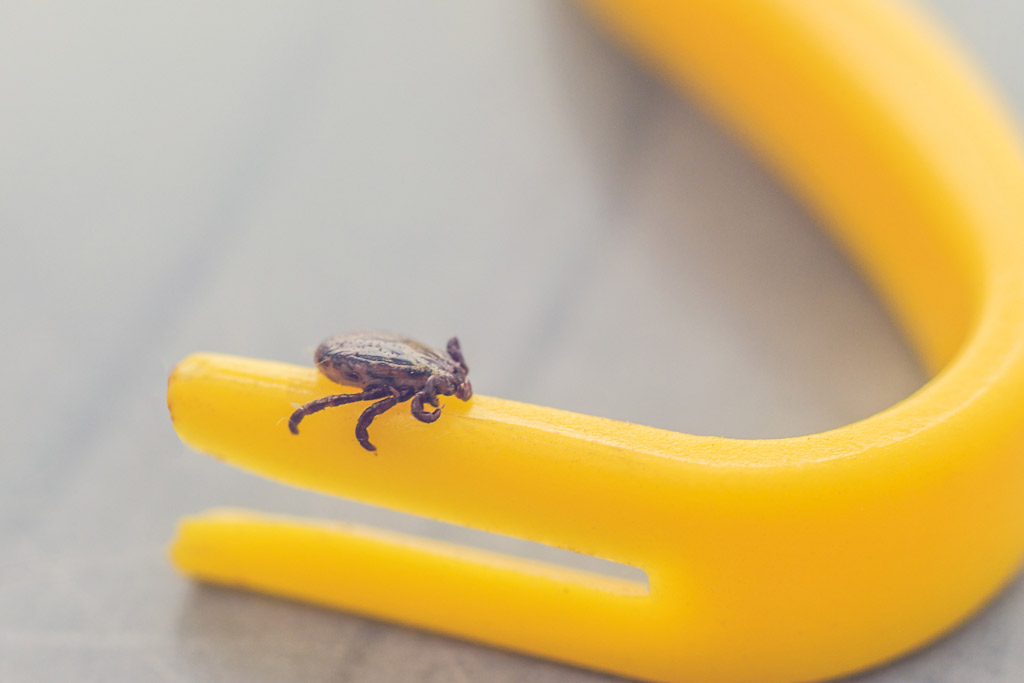
Lice and Mites
Lice and mites are microscopic organisms that feed on your dog’s skin and cause itching, hair loss, and infection.
Generally speaking, lice and mites are two different species, but they function and behave in a very similar way.
Understanding Both
Lice
Lice are small, flightless insects that live in the hair or feathers of animals and people. There are 2 basic types of lice:
- Biting or chewing lice (order Mallophaga) infest both birds and mammals. They feed mostly on skin debris and the secretions of their hosts.
- Blood-sucking lice (order Anoplura) are skin parasites of mammals only.
Typically, lice are species-specific; that is, they do not readily transfer from one animal species to another. Also, note that dog lice and human lice are different species. While humans may occasionally be bitten by dog lice, they will not get an infestation.
Lice live in a dog’s hair and can be killed with an insecticide used for ticks or fleas.
Mites
Mites are of the arachnid family and are a fairly common health concern for dogs. They are parasites that can cause a range of skin conditions, from dry skin to hair loss.
Mites live in the fur, or sometimes in the ears, and can make life uncomfortable for your dog. Mites are also what cause:
- Mange: A well-known skin condition in dogs.
- Scabies: Caused when mites burrow into the dog’s skin. It affects the ears, elbows, legs, and face.
- Walking dandruff: Affects your dog’s head, back, and neck.

Signs of Lice and Mites
If you notice the following symptoms in your dog, they may have lice or mites:
- Hair loss (either in patches or all over their coat).
- Dandruff.
- Excessive scratching.
- Visible irritation, such as red skin.
- You can spot the parasites when looking closely when parting the fur.
Note that all mites should be diagnosed by a skin scraping test by a veterinarian.
Lice and Mites Prevention
Follow the same prevention protocol that I mentioned for fleas. Also, for ear mites, it’s good to keep your dog ears clean, as part of his grooming ritual.
Check our Dog Grooming at Home blog post for more on developing a grooming ritual for your dog.
Lice and Mites Treatment
Like when treating fleas, you can use an anti-parasite shampoo or a natural treatment.
Can Dog Parasites Be Transmitted to Humans?
Intestinal parasites in dogs pose a health risk to humans. According to PetMD, children are at the most serious risk, especially if they play in an environment where dog, cat, or raccoon faeces may be present, such as the garden or a sandbox.
Roundworms are the most common parasite to be passed on from dogs to humans, and cases are more prevalent among children.
You can reduce the risk of infection by worming your dog regularly and by good hygiene such as washing your hands after handling your dog and before eating.
Lastly, people are also subjected to contracting fleas, ticks, lice, and mites, which easily pass between species.
How to Manage
Dog parasite prevention and treatments are a continuous activity for dog parents.
To avoid parasite problems before they start, it’s best to:
- Prevent parasites with medication or alternatives, especially depending on where you live.
- Monitor your dog with annual screening tests from your veterinarian and watch for changes in your dog.
- Maintain a clean environment for your dog.
Just think about it as a routine check for your dog’s health and as another task for your household cleaning protocol.
Take this to the next step and find out more about caring for your dog by heading over to our Dog Health and The 5 pillars to a happy and healthy dog guides.
Lastly, not everything can be prevented, which is why having dog insurance can especially help you save on vet bills. With Petplan pet insurance, you get the coverage, support and resources you need to be the best pet parent ever.
